Published Feb 28, 2017
Michael Westmore Talks Makeup Man Memoir
Michael Westmore Talks Makeup Man Memoir

Michael Westmore heard it for years and years and years: You should write a book. And he wanted to for much of that time; in fact, he kinda, sorta did so, jotting notes on paper, by hand. After all, he’s part of the iconic Westmore family, royalty in Hollywood makeup circles. He worked on everything from Rocky, Land of the Lost, Raging Bull, Mask, Capricorn I and Blade Runner to First Blood, 2010, Iceman, Clan of the Cave Bear, Psycho 3 and Roxanne. He’s won an Oscar (for Mask). And, of course, he led the award-winning makeup teams that created all of the wondrous aliens for Star Trek: The Next Generation, Deep Space Nine, Voyager and Enterprise, as well as the TNG features, not to mention other Trek projects.
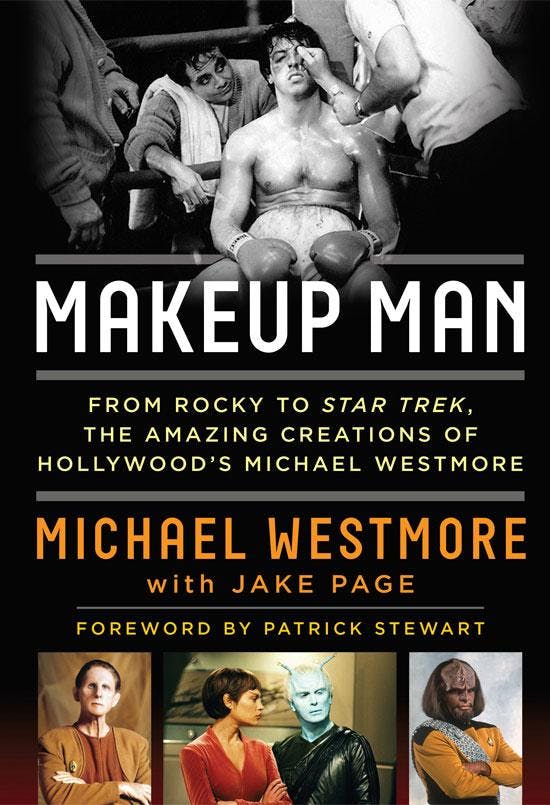
Now, finally, fans can read Westmore’s story in Makeup Man – From Rocky to Star Trek, The Amazing Creations of Hollywood’s Michael Westmore. Available now from Lyons Press, the book was written with the help of the late Jake Page and features a foreword by Patrick Stewart. And it’s not just about Star Trek. Actually, it’s maybe 1/3 devoted to Trek. The rest dives into his family’s history, reveals anecdotes about Bette Davis and Elizabeth Taylor, and goes into depth about his many pre-Trek credits. There are even a couple of recipes. Yes, recipes. StarTrek.com recently engaged the effusive, chatty Westmore in a freewheeling conversation about the book, and here’s what he had to say:
What took so long, and once you decided to finally do it, what was it like to put pen to paper?
I tell you, it started in 2003. It's funny, I was sitting in the office, and I was just thinking about all the things I'd done. I had been writing for Makeup Artist Magazine for three years at that point. I thought, "Gee, it'd be interesting if I just jot down some notes on piece of paper." The whole idea in the beginning was not so much to write a book, but to do something for my kids where I would write down some memories, because they grew up through all of this, and I thought, "I may never find a publisher for it, so I might even self-publish it", just to they would have some type of a record. I started writing it, and we still had two years to go in Star Trek at that point, and I wrote more. I asked my secretary… I said, "Get me a legal pad. A yellow pad," and I started writing. I wrote three full legal pads full of notes, and none of it's in the book. I literally started with myself as a child, being born.
Then I got up to my apprenticeship, and then I kept writing, and then over the years it's like all of a sudden I would be thinking about, "OK, Masters of the Universe. What do I remember about Masters of the Universe?" I'd sit and I'd make notes and write it all down. I collected all of these yellow pads. Then I said, "You know, I'm going to type them up again, because there's things I forgot that I want to switch things around."
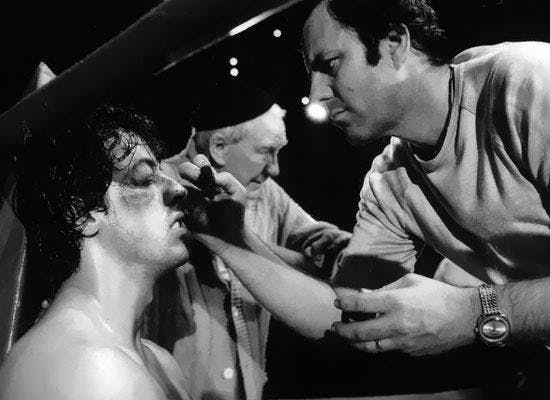
At that point, you finally made the transition to a computer, right?
Right. I'm not that big on computer work, so I literally sent these things as emails to myself, and I collected this giant stack of emails, of which, when I finally got around to putting it together, my son found a technique of being able to convert the emails to Word and re-write the whole thing another time. Other things that I had forgotten. Anyway, having to work and doing other things, I maybe stopped for a month and then would go back and write a story. I was continually stopping and starting, as opposed to sitting down and just pondering it. I would think about something, like Rocky, and I would try to just think of the things before I ever picked up the pen or the pencil to jot it down.

Enter your late collaborator, Jake Page…
Exactly. Once I finally got it together, there was a man – Jake – who did an article on me for Smithsonian Magazine years ago. By the time he passed away he’d written 49 books, and his wife was a professional photographer, and he came to Paramount Studios. Jake said to me, "I don't know why,” he said, but he was working for Smithsonian Magazine at that time, he got a call from the head of Smithsonian that he should go to California and do an article on me for the magazine. He came out to California in either 2000 or 1999, and he stayed for a week. He literally came every day and would go to the set and talk to the makeup artists and talk to me and everything, and the article was published in the May issue in 2000. It’s probably one of the best things that was ever put together on me. It was so in-depth because we’d spent a week, literally, talking, and I’d taken him to the labs and showed him how everything was done.
I finally had reached a point where my writing was, to me, wasn't sufficient. I found Jake. He had retired, and he was living in Colorado. I called him and I said, "Jake, I've got an idea, and I've got a lot of pages. You want to help me with it?" He said, "Let's do it." He was retired, so it literally gave him something to do it. His background was unbelievable, where he himself had been the editor of magazines and newspapers and everything. He spent the time with me putting together a basic outline that we could send to publishers. Some people were not interested, but Lyons Press loved it, and they said, "Let's do it." We went with Lyons Press and they gave me nine months to wrap it all up and get it done and find the pictures and everything. I put it all together and it was 300 and some pages. I was expecting to do rewrites and all of that.
And then Jake passed away in Feb. 2016…
During those nine months, he died. My writing mentor and go-to guy was no longer in existence. Michael, my son, transferred everything over. He had a punctuation program. So we fixed commas and periods as best we could, and then the publishing house said, "Don't worry about it. We'll clean it up from there." I said, "You know, I'm not really a writer," and I was so used to Makeup Artist Magazine. There was an editor there who, every time I sent an article in, would rewrite it to the point I didn't even recognize it was me. I literally quit writing for them, in about 2012. I said to the Lyons people, "Are you going to rewrite me?" They said, "No. We really like it in your own words." In reading the book, it's in my own words. It isn't somebody else who has corrected anything.

For people who only know you from Star Trek, what do you think they will be most surprised to learn about you and your career if they pick up Makeup Man?
That I had a whole career before Star Trek, because only maybe a third of the book is about Star Trek. All these other movies I started working on, literally in 1961, that's where I had to start the book. So, I still have three legal pads sitting here that I haven't gone back into for years, which I may do one of these days. There may be something interesting in there to go ahead and find again. In fact, in the beginning, I wasn't going to put any Star Trek in it because I was going to do another book with just Star Trek. The publisher said, "No, we have to. Your name is so connected with it that people will buy it expecting something, and if it's not there…" ...
So, I took a different approach. As opposed to writing about the typical type of aliens and things on Star Trek, I had Armin Shimerman and Rene Auberjonois and Patrick Stewart people write little things for me, of what it was like for them to go through this experience. That's what a lot of the Star Trek angle is in the book. I tried to pick out spots that were not just the humans or the crew, the human crew, but tried to take what I thought were the humanoids and creatures that were featured in different episodes, and give my background on them of what my inspiration was and how we did it. Then getting the people themselves to actually give their insight of how they developed their character, how they felt wearing the makeup, fleshes that out.
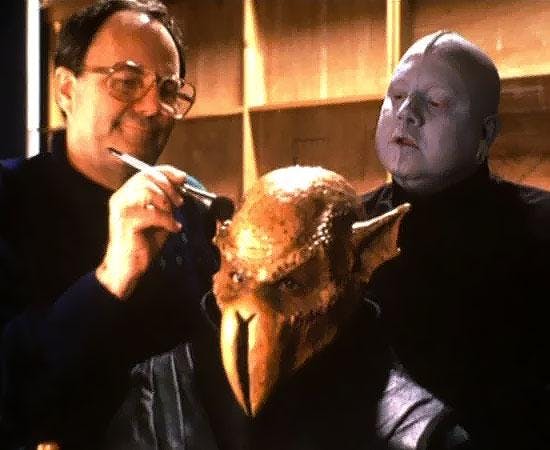
You've done tons of interviews over the years about Star Trek specifically, including a couple with us here at StarTrek.com. What would you say is new in Makeup Man for Star Trek fans, that they don't know, aside from what Rene, Patrick and Armin have written?
There are some stories in there, too, where I give specific accounts of a few of the different episodes and talk about things that had never really come up for some reason along the way. I tried to take a fresh approach to the writing. I tried not to do the same old, same old. Aliens and Artifacts covered so much of that, and really well. So, for the Trek portion of Makeup Man, I tried to tell the stories behind the aliens and artifacts.
Auberjonois shares a very cool anecdote…
Yes, he says that he couldn't even use that Odo voice without being in the makeup. It didn't work just with somebody saying, "Oh, talk like Odo." He said he couldn't do it. It was interesting to find out what the actors actually felt like when they looked at themselves in the mirror as their characters.
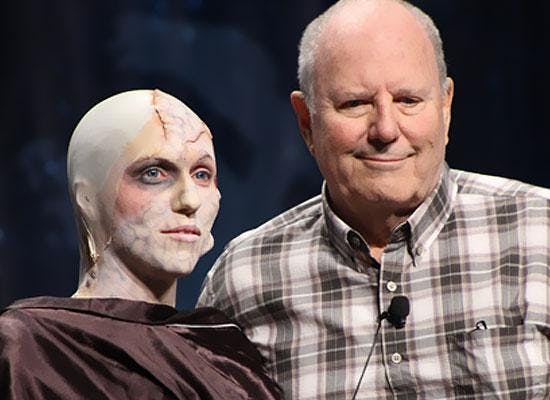
One question we’ve wanted to ask you about doing the makeup for Trek is this: The choice to make every alien humanoid came from the top, from Gene Roddenberry. How tough a constraint was that on you?
I think I just mention it in the book, but that's what Gene wanted. His whole concept was that the people had to be able to talk, and they had to be able to see. He didn't care how I designed the bone structure around the eyes, or put contact lenses in them, or put fake teeth in them or something, or rubber lips, whatever. He didn't care if I did any of that. It's just that they had to be able to move so you would believe that there was a living creature inside of it.
The big one I remember was Mick Fleetwood, when he became a fish. He could actually kind of talk, but he didn't have eyes that blinked. In fact, the great big eye on there, opticals made it blink once in the very beginning when you see him so you get the idea that, yeah, he can blink, and then you don't have to spend the money to do it anymore. But we really didn’t do anything like that very often, and we did less and less of it over time. And, was it constraining? No. It just gave me a fun time trying to figure out how to create a mouth, lips and, as I said, an orbital around the eye that could be different. Actually, by the time we closed shop in 2005, I still have a book filled with sketches that were never used. In every one of them there are usable eyes and a usable mouth to be able to talk.
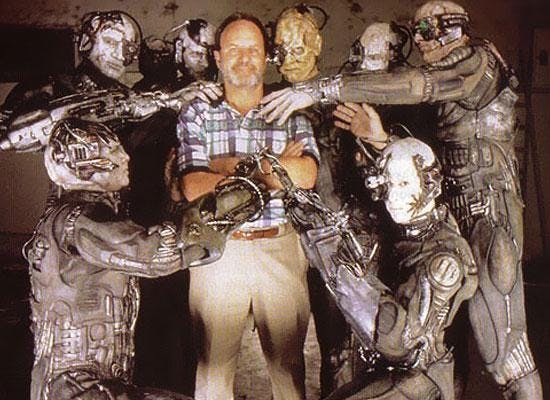
Not to be at all negative, but the Trek faithful may take you to task for using the word Borgs as the plural of Borg.
(Laughs). Not only do I have S's on the Borg, but, in fact I found in other places, too, that I've mentioned names and put S's on the end of them when I shouldn’t have. If that's the worst criticism, I'm fine.
We are going to make the chili recipe you include in the book, which you say Elizabeth Taylor loved and ordered from the long-gone, beloved Chasen’s in Hollywood…
Good. You should. I've done it. Here’s how much she loved Chasen’s chili. She was working on Cleopatra in Europe and had it frozen and sent to her there. Or that’s the rumor, the legend. When I met her in the 80s, she still loved that chili. It was literally one of her favorite dishes. One day when I was working with her, she had it sent over for lunch. I said to her, "God, I'd really love to make it." She said, "Let me see if I can find the recipe." Somebody over there scribbled it down. It had actually been a secret recipe for many, many years, but I think what Elizabeth got was as close to the real thing as anyone could ever get.
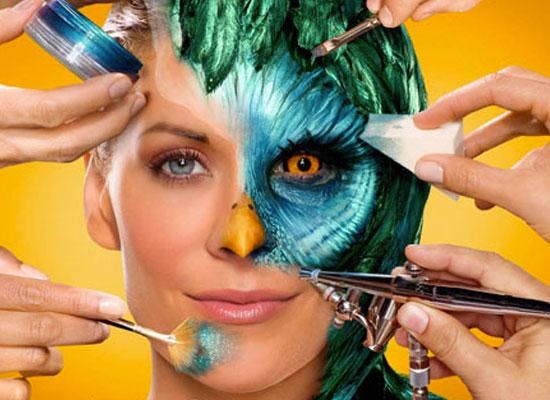
Before we let you go, what else are you working on at the moment?
We banked three seasons of Face Off, so that’s on the side. Presently, I have an exhibit in Santa Barbara that is 90% Star Trek and 10% movies, with Raging Bull, Rocky and Mask in it. It’s running until the end of April at The Art, Design & Architecture Museum at the University of California, Santa Barbara. I have been going back and forth, giving talks, and I’ll be doing a book signing there next month. So, that's been keeping me busy, just having to put that together. Then, with all the things I've dug up to be able to put in the museum, we only had room to put about half the things up. I'm hoping when it closes in April we'll be able to move it to another location. I don't want to bring it all home and store it. I'd just as soon have it go sit where people can enjoy it, because it's turned out to be a very successful exhibit.
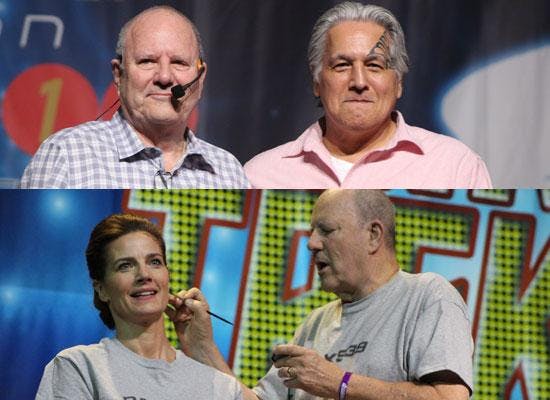
And, lastly, we know that you’ll be at Star Trek Las Vegas in August. In the past, you’ve transformed Terry Farrell back into Dax and Robert Beltran into Chakotay again. What are you planning to do this year?
This year, I don't know yet. We did a Borg makeup last year. I don't know if we're going to actually do a makeup or not this time, because I'm going to be doing a book signing. So, it may just be a talk with me about my career and Trek and the book and everything, followed by a signing.
Makeup Man is available now from Lyons Press, priced at 29.95. Go to www.amazon.com to purchase it.

